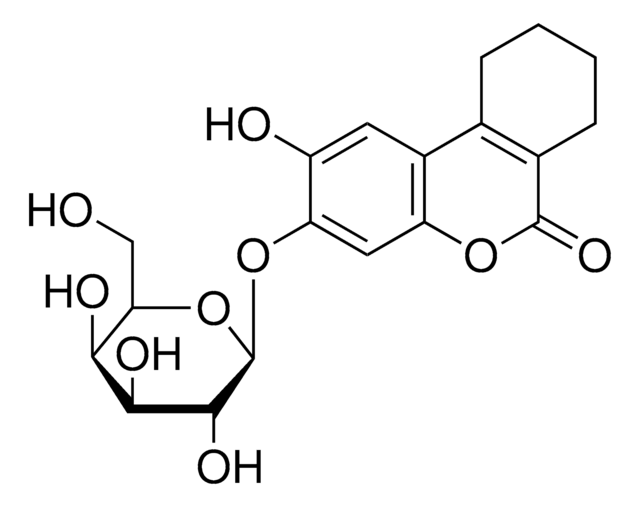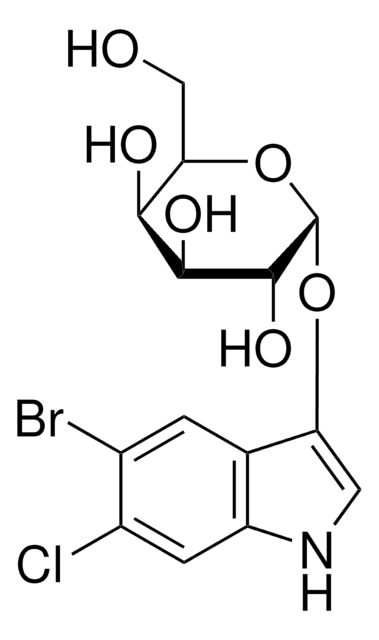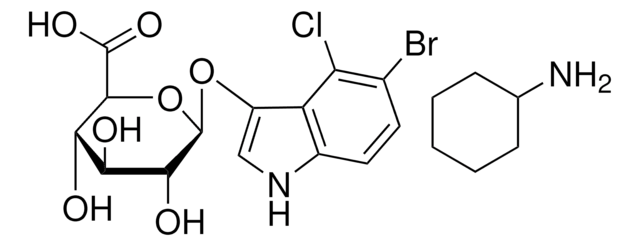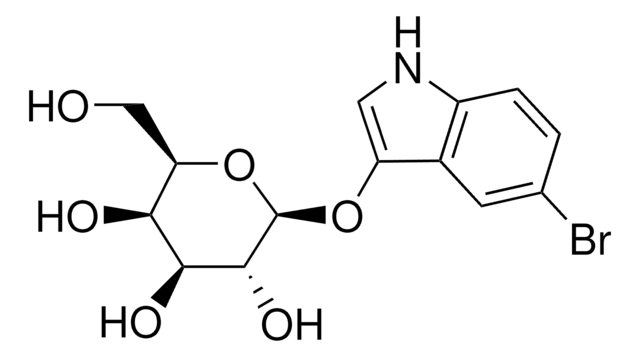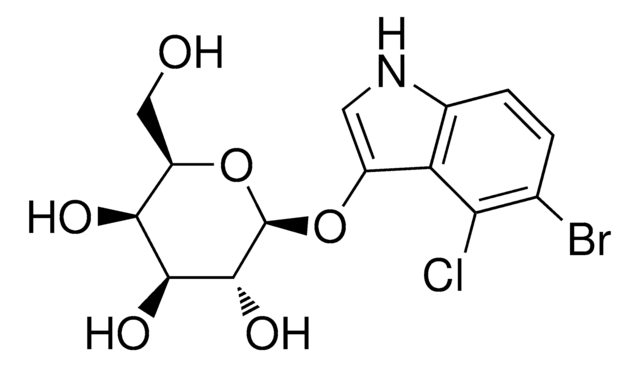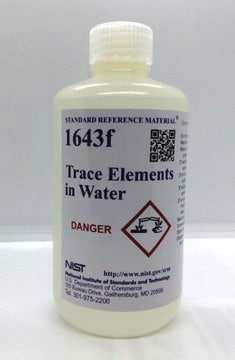S7313
S-Gal® sodium salt
reagent for selection of recombinant bacterial clones
Synonym(s):
3,4-Cyclohexeneoesculetin-B-D-galactopyranoside sodium salt
Sign Into View Organizational & Contract Pricing
All Photos(3)
About This Item
Empirical Formula (Hill Notation):
C19H21O9Na
Molecular Weight:
416.35
MDL number:
UNSPSC Code:
12352200
NACRES:
NA.85
Recommended Products
grade
for molecular biology
sterility
non-sterile
Assay
≥95% (HPLC)
form
powder
IVD
not for in vitro diagnostic use
solubility
H2O: 100 mg/mL
suitability
suitable for β-galactosidase test
storage temp.
room temp
General description
S-Gal® (sodium salt) is an autoclavable, water-soluble, chromogenic substrate for β-galactosidase, used to determine the presence or absence of a cloned DNA insert in bacteria growing on agar plates. S-gal® is designed to replace X-Gal in blue-white selection of recombinant bacterial colonies with the lac+ phenotype.
Application
S-Gal, sodium salt is a patented water-soluble, autoclavable chromogenic substrate for β-galactosidase that is designed to replace X-Gal in blue-white selection of recombinant bacterial colonies with the lac+ phenotype.
Features and Benefits
- More intense color contrast than X-gal
- Water-soluble and autoclavable for easiest use
- Excellent for use in automated colony counters
- No need to make stock solutions
When S-Gal is cleaved by β-galactosidase, the resulting product will chelate ferric ion to create a black, insoluble precipitate. Lac+ colonies grown in the presence of S-Gal and ferric ion turn an intense black color, allowing for easy differentiation between lac+ and lac- colonies. S-Gal, Sodium salt is water soluble, eliminating the need for solvents such as dimethyl formamide. S-Gal is also autoclavable and can be added to your medium of choice prior to autoclaving. S-Gal is not light sensitive and does not require any protection from light sources.
Other Notes
More water soluble version, soluble >50 mg/mL.
The ferric or Fe3+ ion is required for color development and must be added to any S-Gal®
formulation. A medium prepared with S-Gal® is moderately dark due to the presence of ferric ammonium citrate. This darker background often provides enhanced contrast for automated colony counting or isolation.
formulation. A medium prepared with S-Gal® is moderately dark due to the presence of ferric ammonium citrate. This darker background often provides enhanced contrast for automated colony counting or isolation.
Caution
For black color development to occur, ferric ion must be present. Although we recommend ferric ammonium citrate (500 mg/L of media), other ferric compounds can be used to provide this requirement, depending upon your particular system.
Principle
When S-Gal® is cleaved by ß-galactosidase, the resulting product will chelate ferric ion to create a black, insoluble precipitate. Lac+ colonies grown in the presence of S-Gal® and ferric ion turn an intense black color, allowing for easy differentiation between lac+ and lac- colonies.
Linkage
Ferric Ammonium Citrate (F5879), LB Agar (L2897), IPTG (Isopropyl β-D-thiogalactopyranoside, I6758), Ampicillin (A2804), Kanamycin (K0879), Chloramphenicol (C7795), Tetracycline (T8032)
Reconstitution
Add to agar media pre-autoclaving at a recommended concentration of 300 mg S-Gal/L of media, along with 500 mg/L Ferric Ammonium Citrate (F5879). Stock solutions of S-Gal can be made by dissolving at 50 mg/mL in deionized water, sterile-filtering and storing at -20 °C.
Stock solutions of S-Gal® (sodium salt) can be made by dissolving 50mg/ml in water, dimethyl formamide (DMF) or DMSO. Filter sterilize and store at -20C. Add S-gal® (300 mg/L from stock solution or powder) and Ferric Ammonium Citrate (500mg/L) to agar media prior to autoclaving.
Legal Information
S-GAL is a registered trademark of Merck KGaA, Darmstadt, Germany
Storage Class Code
11 - Combustible Solids
WGK
WGK 3
Flash Point(F)
Not applicable
Flash Point(C)
Not applicable
Personal Protective Equipment
dust mask type N95 (US), Eyeshields, Gloves
Certificates of Analysis (COA)
Search for Certificates of Analysis (COA) by entering the products Lot/Batch Number. Lot and Batch Numbers can be found on a product’s label following the words ‘Lot’ or ‘Batch’.
Already Own This Product?
Find documentation for the products that you have recently purchased in the Document Library.
Customers Also Viewed
S-Gal?, A novel 1H MRI reporter for ?-galactosidase?
Weina Cui
Magnesium Research (2010)
Weina Cui et al.
Magnetic resonance in medicine, 64(1), 65-71 (2010-06-24)
Reporter genes and associated enzyme activity are becoming increasingly significant for research in vivo. The lacZ gene and beta-galactosidase (beta-gal) expression have long been exploited as reporters of biologic manipulation at the molecular level, and a noninvasive detection strategy based
Winfried Hense et al.
PLoS biology, 5(10), e273-e273 (2007-10-12)
Genes with male- and testis-enriched expression are under-represented on the Drosophila melanogaster X chromosome. There is also an excess of retrotransposed genes, many of which are expressed in testis, that have "escaped" the X chromosome and moved to the autosomes.
Our team of scientists has experience in all areas of research including Life Science, Material Science, Chemical Synthesis, Chromatography, Analytical and many others.
Contact Technical Service